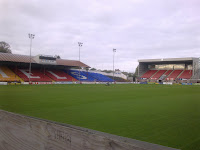Shelbourne FC from Dublin in Ireland were formed in 1895, joining the the all Ireland Irish League in 1904, before becoming founder members of the League of Ireland in 1921. By then the club had moved into Shelbourne Park in 1913 having moved from Havelock Square near to Lansdowne Road.
 |
| Shelbourne Park is Dublin's premier greyhound racing venue in modern times. |
The club lifted the FAI Cup for the first time in 1939 before winning two more league championships in the 1940's. The final match at Shelbourne Park was a 2-2 draw with Waterford in April 1949. The stadium still exists for greyhound racing. Shels intended to build a new ground at Ringsend.
A sixth title was won in 1953 and then in 1955-56 Shels played their only season at Ringsend Stadium. They lasted only one season there as there was no shelter for the fans. A redeveloped stadium still exists as Irishtown Stadium in Ringsend Park. Shels moved to play games at Tolka Park to share with Drumcondra. The club had pride in playing young players. Tony Dunne was soon picked up by Manchester United, where he went on to win a European Cup winners medal.
More honours followed in 60's in the form of two FAI Cups and a league title as the club finally sold off Ringsend. It was a tough period for clubs in Ireland as football from England started to be televised, thus affecting attendances. Shels were regulars in European competitions from that period onwards.
The 1970's saw troubled times for the club, despite the legendary Jimmy Johnstone briefly appearing. By now Shels were playing at a dilapidated Harolds Cross Stadium and had a brief spell in the second tier as the league was expanded.
However, good times were coming as Tony Donnelly took over the club and bought the disused Tolka Park for the club. Honours were soon arriving at their new home with a League of Ireland title and FAI Cup being won within a couple of years. Damien Richardson took over as manager and delivered another league title in 1996. The cup was retained the following season before the club came close in all three domestic trophies. Richardson departed to be replaced by the uncompromising Dermot Keely.
Keely delivered the clubs first ever league and cup double in 2000 before their tenth title was secured two years later after closest rivals St Patrick's Athletic had fifteen points deducted for fielding an unregistered player. More titles were added in 2002, 2003 and 2006 under new boss Pat Fenlon. Unfortunately the club hit severe financial problems so most players were sold off.
Shels were relegated to the First Division because of their financial status as the club were hit by the tragic news that major shareholder Ollie Byrne was suffering from terminal brain cancer. Keely was brought back to manage the team and was then replaced by Alan Matthews as Shels reclaimed their top flight status.
Shelbourne FC will compete in the League of Ireland Premier Division in the 2013 season.
My visit
Friday 15th October 2010
I was on the second day of my groundhopping around Dublin and I was feeling pretty seedy. The previous night I had indulged in plenty of the 'dark stuff' around the bars around The Liffey and Temple.
After attempting to eat I took a train from Connolly station north, under the terracing of Croke Park to Drumcondra station. Tolka Park was a ten minute walk up Drumcondra Road and then down Richmond Road. The ground stood opposite the basic facilities of Drumcondra FC who once occupied the stadium and were a leading light in Irish football. Tolka Park looked a fine traditional football ground that were once found in most English towns before the boom in identikit stadiums took hold.
It didn't look good for getting inside until a closer inspection of the large exit gate told me a regular way of admission was possible. The groundsmen were working on the pitch and the gate was unlocked. I opened it slowly and went inside where I found myself by the corner flag.
The ground was indeed traditional, but had been adapted to modern demands. The nearside Main or Richmond Road Stand was low, covered with seats all the way along the touchline. The Ballybough End where I was stood, was a bank of open seats. The Riverside Stand on the far side had a roof over the central section towards the rear as well as a TV gantry. The far Drumcondra or Newtand was a steep covered bank of seats towards the Riverside Stand. It stopped adjacent with the goals where an area of flat open path accommodated facilities for fans. It was obvious much of the ground was once terraced, but Shels had done a fine job adapting Tolka Park and making it a bright and vibrant venue.
I left the ground and the workers to their task and closed the gate behind me. I was delighted to see inside this fine and historic venue and felt slightly better, though not much.
I set off back down Richmond Road for a fifteen minute walk towards Whitehall Stadium, the ground of Home Farm FC.










No comments:
Post a Comment